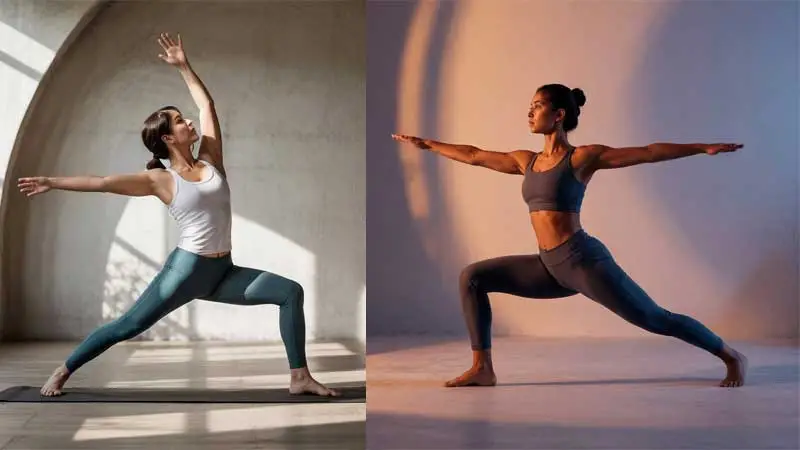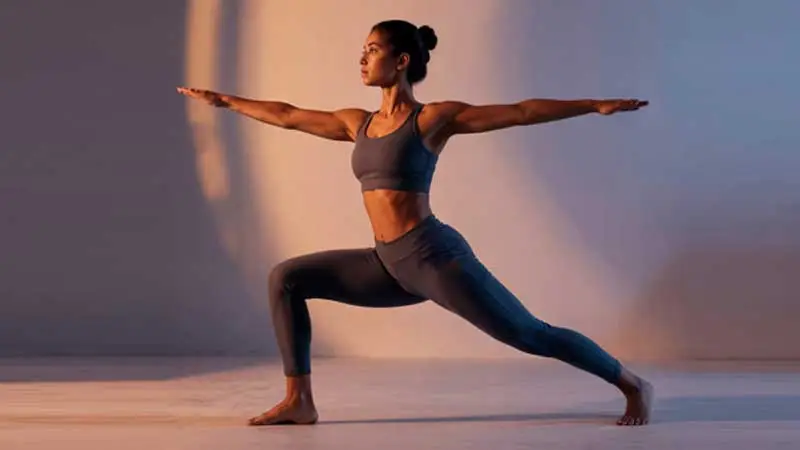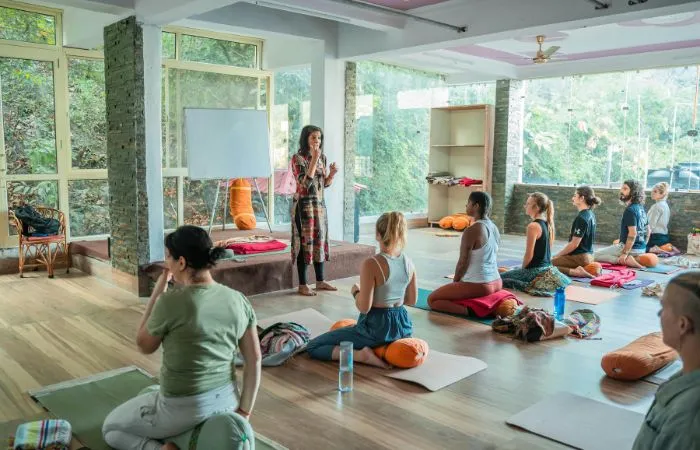
It is the Warrior 2. Pose, also known as Virabhadrasana II, is one of the most popular yoga poses. It is renowned as strong, stable as well as grace. Warrior 2 is more than a simple stretch; it demonstrates balance, focus and determination. No matter if you’re new to yoga or looking to increase your technique, this posture is essential for all.
The Warrior 2 pose enables us to discover the strength of our inner self while anchoring our focus on the present and here and now. The name has a powerful mythological significance.
It’s a reference to Virabhadra as a warrior designed by God Shiva. He was created to defend justice and power. This pose demonstrates the balance between strength and grace, which makes it an essential and revered practice in yoga across the world.
Let’s look at how to be a Warrior 2, why it is important, and what benefits it can bring to your body and mind.
Warrior 2 Sanskrit Meaning
It is the Sanskrit term for Warrior 2 Pose is Virabhadrasana II (veerbhdraasn II).
Meaning Breakdown:
- -“Vira” (viir) is a warrior, hero
- – Bhadra (hdr) = Blessed, friend
- – Asana (aasn) = Pose
The word Virabhadrasana is “the pose of the warrior named Virabhadra.” The story of Virabhadra is a part of Hindu legends; Virabhadra is a strong warrior who was created in the name of Lord Shiva. The pose symbolizes strength, courage and focus, demonstrating the strength and determination of a warrior.

Step-by-Step Guide to Practicing Warrior 2 Position
To be a warrior, here’s how you can confidently transition into Warrior 2. Follow these steps to success:
Simple Warrior 2 sequence
1. Start in Mountain Pose (Tadasana):
Standing straight at on the mat’s front, with your feet spaced hip-width apart. Locate your center, activate your core, and keep your focus on your breathing.
2. Create a Wide Stance:
Step your feet about 3-4 feet apart (adjust depending on your size and flexibility). Turn your right foot towards the mat’s front (90 degrees) while your back (left) foot is turned slightly to the right (around 15 °).
3. Align Your Heels:
Imagine an imaginary line running from the toe of your forefoot all the way to an arch in your rear foot. This alignment will provide stability and grounding.
4. Bend the Front Knee:
Bend your right knee till your knee is level with the ground. Make sure that your knee is directly over your ankle and is not swaying towards either side. Maintain your rear leg straight and steady.
5. Extend Your Arms Horizontally:
Take both arms towards the sides while remaining straight with your palms facing downwards. Spread your fingers like something is gently pulling them apart.
6. Engage Your Gaze:
Your head should be turned to look at your right hand and relax your neck. The focus of your gaze, which is called “drishti” in yoga, symbolizes concentration and intention.
7. Hold and Breathe:
Stay in this position for 5 to 10 minutes. Feel your strength grow as you feel your feet firmly on the ground, extend your spine, and expand your chest.
8. Transition Out:
Make sure you straighten the right foot, then lower your arms, then come back into Mountain Pose or change onto the side to left to gain stability.
Keep in mind that the warrior yoga pose isn’t about perfection It’s about feeling strong and graceful, grounded but flexible. Relax your breathing and let it help you along as you continue to perfect this pose with time.
Benefits of warrior 2 yoga position
Beyond its striking design, Warrior 2 offers numerous benefits, offering full exercise for body and mind. Here are a few of its main advantages:
Physical Benefits of warrior 2 pose
Enhances Muscle Strength:
The Warrior 2 yoga posture is effective in building strength in the glutes, legs, arms and core. In the long run, the effort required to hold this posture results in clearly defined and strong muscles.
Increases Stamina and Endurance:
Long-term hold of Warrior 2 will test your endurance, which makes it a perfect pose to boost your overall stamina.
Improves Hip Flexibility:
The hip-opening aspect of the warrior yoga pose relieves tightness and improves mobility in the hips as well as the groin area.
Fortifies Knees and Ankles:
Through a series of exercises that target the muscles around your ankles and knees, Warrior 2 promotes joint stability.
Promotes Good Posture:
Warrior II yoga pose can help open your chest and help align your spine. It helps reduce the negative effects of sitting and slouching for long periods.

Benefits warrior two pose benefits
Enhances Concentration and Clarity:
The focused eye that you can see in Warrior 2 trains you to be focused and present while minimizing distractions.
Boosts Self-Esteem:
Being confident in this position helps build self-confidence and resilience.
Alleviates Stress:
Breathing in sync with the movement of Warrior 2 activates the parasympathetic nervous system, which aids in reducing anxiety and stress. This posture serves as an opportunity to remind ourselves that the true power is in balance and mindfulness rather than brute strength.
Common Pitfalls to Avoid:
While most can do Warrior 2, there are some common mistakes to keep in mind. Beware of these, and you’ll aid in avoiding injuries and increase the benefits of this pose.
Misalignment of the Front Knee:
Keep your front knee straight above your ankle. If it moves inward or outward, it can result in strain. Drawing a straight line from your knee to your second toe could assist in assessing the alignment.
Dropping the Back Arm:
Don’t allow your back arm to relax. Both arms must maintain equal strength and force as if you’re stretching both ways.
Overextending the Spine:
Keep your torso upright without leaning too far backward or extending your lower back too far. Keep your chest up while you engage your core.
Ignoring the Back Leg:
Some people focus too often on the front leg and forget to engage the back leg. Maintain it straight and active to help improve balance.
Being aware of your alignment does more than protect your body. It also improves the benefits of the pose.
Easy warrior 2 Sequence For Beginners
If you’re beginning to learn about the practice of yoga, Warrior 2 might initially appear daunting. Here are a few tips to make it more manageable:
Narrow Your Stance:
If a broad stance feels overwhelming, consider bringing your feet closer. This will allow you to benefit while increasing your strength gradually.
Utilize Props for Assistance:
If you find it difficult to maintain balance, consider putting a chair close by or a wall to provide support.
Practice in Front of a Mirror:
Using a mirror when you are practicing Warrior 2 can help you examine how you are performing and then make the necessary adjustments.
Concentrate on Your Breathing:
Let your breath guide you. Deep, steady breaths to secure yourself in the posture.
Exercise Patience:
The development of flexibility, strength and endurance requires time. Be focused on the journey rather than chasing the perfect result. Yoga is about the process, not the final product.
Harnessing Warrior Energy Beyond the Mat:
While Warrior 2 is fundamentally a physical exercise, its principles frequently transcend yoga classes. The focus, strength and stability that are cultivated in this posture can help you face everyday problems.
Consider ways you can tackle difficulties with the same determination and determination that you have in the warrior two positions. This will help you make tough decisions, navigate hectic schedules, and achieve your objectives. Face challenges by embracing the warrior’s spirit.
What is the cause of knee pain when you do the Yoga Pose Warrior 2?
Knee discomfort is a common occurrence in Warrior 2 (Virabhadrasana II) and typically occurs due to muscle weakness, misalignment or repetitive use. Here are a few common reasons:
1. Misalignment Issues
The front knee moves inwards: The front knee must be just over the ankle. If it turns inward, it can strain the inner knee ligaments.
Forward Knee Past toes place excessive pressure upon the knee joint instead of using the glutes and thighs.
– Back Leg Misalignment When the lower back isn’t properly aligned, it could cause instability and impact the knee.
2. Weak Muscles and Lack of Engagement
The weak quadriceps and glutes If the muscles are weak, your knees are unable to support the pressure, which causes pain.
Tight Hips or In the Thighs: A lack of hip motion can force the knee into uncomfortable positions, which can cause strain.
3. Overuse or Pre-existing Conditions
Knee injuries from the past: Previous injuries, such as meniscus tears, could become more severe in this posture.
– Joint and Arthritis issues: Patients suffering from knee osteoarthritis might feel pain from joint pressure.
Hyperextension: Locking your back knee may cause ligament strain.
How to Avoid Knee Pain in warrior 2 yoga pose
- Keep your knee up above your ankle and aligned with your second foot.
- Use your glute and thigh muscles to support your knee.
- Your weight should be evenly distributed on both legs.
- Maintain your back leg’s strength and active But don’t lock your knee.
- Make use of props such as blocks beneath your thigh in front of you If you require assistance.
- Move your thighs and hips prior to your practice.
Final Reflections warrior ii pose:
Warrior 2 transcends being merely the yoga posture. It is a symbol of elegance, strength, and determination. No matter what level of experience you have, beginner or advanced, this pose offers numerous opportunities to grow personally. Each time you practice Warrior 2, you focus on your breath, build your muscles, as well as cultivate an environment that is calm and peaceful.
If you decide to roll your mat, channel the inner warrior within you and dedicate yourself to this posture. If you practice regularly and are focused, Virabhadrasana II will give you clarity and strength in yoga as well as in your daily life. Namaste!




